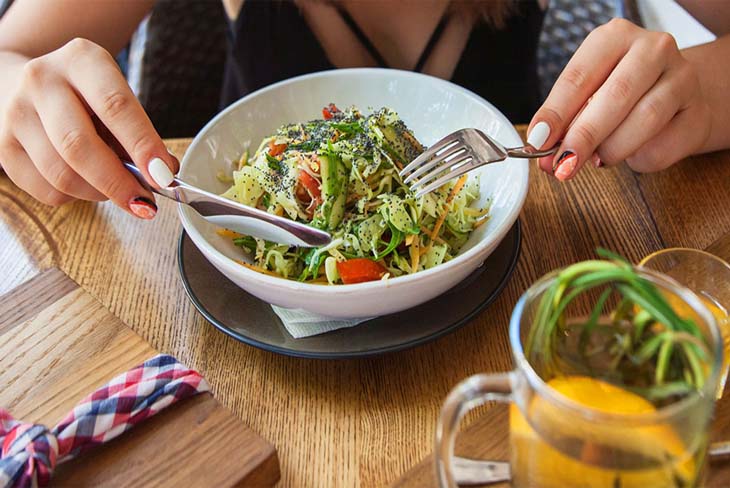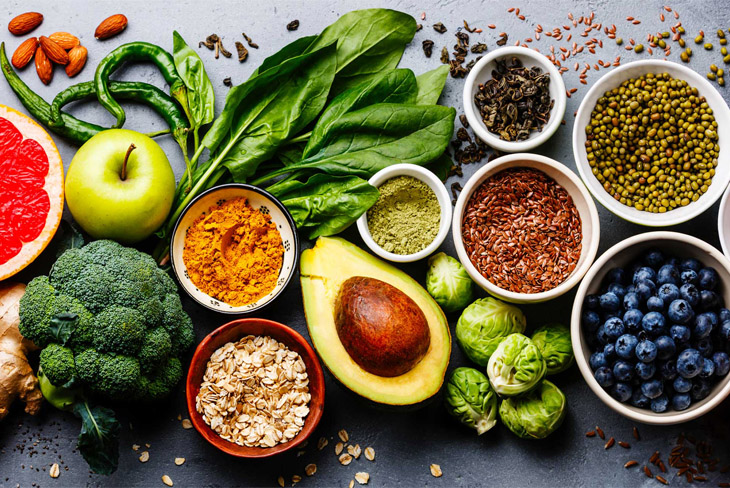Should you become a vegetarian?
Nội dung chính
People choose a vegetarian diet for many reasons. For some people, eating vegetarian is a way to be healthier or to avoid hormones used in animal foods. For others, eating this way has more to do with religion, animal rights, or environmental concerns.
If you’re considering a vegetarian diet, you’ll want to consider what type of vegetarian you’ll be. Once you’ve decided which foods you’ll avoid, you’ll also want to come up with a plan to ensure that you’re able to get all the nutrients your body needs.
Types of vegetarian diet
There are several different types of vegetarian diets:
Vegetarian
If you follow a vegetarian diet, that means you don’t eat meat, poultry, or fish. This category of eaters can be further divided by what animal products you choose to include in your diet:
- lacto-ovo vegetarians eat both eggs and dairy products
- lacto vegetarians eat dairy products but not eggs
- ovo vegetarians eat eggs but not dairy products
Vegan
If you’re following a vegan diet, you don’t eat meat, poultry, or fish. You also don’t consume dairy products, eggs, or other animal products, like gelatin or honey.
Partial vegetarian
A partial vegetarian doesn’t eat meat but does eat some animal foods.
- pescatarians eat fish but avoid all other meat
- pollo-vegetarians eat poultry but avoid other meat and fish
Flexitarian
Others follow what’s known as a semi-vegetarian or flexitarian diet. People following this diet eat mostly plant-based foods but may occasionally include meat, dairy, eggs, poultry, and fish in small amounts.

What are the health benefits of a vegetarian diet?
There are many benefits to a vegetarian diet when it’s followed correctly. If you’re avoiding meat but only eating processed breads and pastas, excess sugar, and very little vegetables and fruits, you’re unlikely to reap many of the benefits of this diet.

Good for heart health
Vegetarians may be up to one-thirdTrusted Source less likely to die or be hospitalized for heart disease. Of course, food choices matter — vegetarian or not.
If you want the heart-protective benefits of the diet, be sure to choose:
- high-fiber whole grains
- legumes
- nuts
- vegetables and fruits
- other low-glycemic foods
The idea is to consume soluble fiber and choose foods that’ll help keep blood sugar levels stable. By doing so, you may reduce your cholesterol and overall risk of heart attack.
Reduces cancer risk
While the benefit isn’t significant, vegetarians may have a slight edge with lowering cancer risk.
One studyTrusted Source found that, in low-risk populations, a vegetarian diet reduced the risk for cancer in general. Additionally, the study found that certain types of animal-free diets reduced the risk for specific types of cancer:
- a vegan diet was found to reduce risk for cancer more than other diets
- a vegan diet was also found to offer the most protection against female-specific cancers
- a lacto-ovo vegetarian diet was found to offer the most protection against cancers of the gastrointestinal tract
However, another studyTrusted Source found only a nonsignificant decrease in risk for colorectal cancer among people following a vegetarian diet.
Many studies claim that a diet full of fresh fruits and vegetables may be the key. Being vegetarian may make it easier to get in the daily recommended five servings.
Being exclusively vegan isn’t absolutely necessary either because a plant-based diet with heavy fruit and vegetable intake can also be beneficial.
Prevents type 2 diabetes
Following a healthy vegetarian diet may help preventTrusted Source and treatTrusted Source type 2 diabetes and associated complications. It goes back to choosing low-glycemic foods that keep blood sugar levels steady, such as whole grains, legumes, and nuts.
In one study, vegetarians had half the risk of developing type 2 diabetes compared with non-vegetarians.
Lowers blood pressure
Long ago, researchers started noticing that people who don’t eat meat may have lower blood pressure. Studies have shown that vegetarians, particularly vegans, have lower blood pressures than their meat-eating counterparts.
Plant foods tend to be lower in fat, sodium, and cholesterol, which can have a positive effect on your blood pressure. Fruits and vegetables also have good concentrations of potassium, which helps to lower blood pressure.
Decreases asthma symptoms
An older Swedish study suggests that a vegetarian diet, specifically vegan, may decrease symptoms of asthma. Twenty-two out of 24 participants who ate a vegan diet for a year saw improvements, including less dependency on medications.
It’s thought that certain animal foods may produce an allergy or inflammation response, so removing these foods from the diet can reduce these responses.
Promotes bone health
Osteoporosis rates are lower in countries where people eat mostly vegetarian diets. Animal products may actually force calcium out of the body, creating bone loss and osteoporosis.
In one study, people who followed a lacto-ovo vegetarian diet for 20 years or more had only 18 percentTrusted Source less bone mineral by the time they reached age 80. Omnivores, or meat eaters, in this study had 35 percent less bone mineral at the same age.

Is a vegetarian diet safe?
The risks associated with following a vegetarian diet surround deficiencies in certain vitamins and minerals, like vitamin B-12, and omega-3 fatty acids. The foods you choose make all the difference.
You can technically be a vegetarian eating a diet made up entirely of snack cakes, french fries, and milkshakes, which have little nutritional value. As a result, the many health benefits may not apply.
Remember: Empty calories can creep into any type of diet, meat-free or not.
What about in pregnancy and for children?
Pregnant women and nursing mothers can get the nutrients they need from a vegetarian diet. The same is true with children.
If you’re following a vegan diet and you’re pregnant, nursing, or a child, you may need to supplement with additional vitamin B-12, vitamin D. Additional iron, folic acid, and omega-3s may also be a good idea, though vegetarians may actually consume more folic acid than people on a diet that includes meat. Learn more about supplements you may need on a vegan diet.
How to become a vegetarian
Set a date…or don’t
Should you go cold tofurkey? That’s up to you. You may choose to mark your calendar with the date you’ll start your vegetarian diet. Or you may decide to go with a more gradual approach.
You may find it works best to first give up red meat, then poultry, then fish. Or you may switch over your pantry to all vegetarian to start with a clean slate.
You may also choose certain days of the week to go vegetarian, like practicing Meatless Mondays. You can slowly add more days as you get more used to following this diet.
Resist temptation
There are many forms of the vegetarian diet, so it’s not always an all-or-nothing situation. That said, if you’re looking to avoid certain foods for a specific reason, you may consider looking for tasty alternatives by browsing around the grocery store.
You can find veggie burgers, “chicken” nuggets, and all sorts of meatlike alternatives. Keep in mind that some of these foods are processed heavily and may not be the best choice to fill up with on a regular basis.
Another approach is to focus on trying new vegetarian foods instead of focusing on what you can’t eat. Try new vegetables, preparation methods, and meat alternatives. You may discover flavors you didn’t know you liked.

Swap ingredients
You may still be able to cook many of your favorite recipes with a vegetarian or vegan twist. Often, you can replace the main protein with a vegetarian source, like tofu or tempeh. If the recipe has an animal-based broth, you can use vegetable broth instead. If you’re avoiding dairy, try a nondairy milk such as almond or soy.
Here are some swaps:
| Meat, poultry, or fish | Tofu, tempeh, seitan, lentils, textured vegetable protein, jackfruit, mushrooms |
| Cheese | Soy, cashew, other nut or aquafaba-based “cheeses”, nutritional yeast |
| Beef or chicken stock or broth | Vegetable stock or broth |
| Milk | Soy milk, almond milk, coconut milk, hemp milk, rice milk, flax milk |
| Eggs (in baking) | 1 tablespoon ground flaxmeal or chia seeds + 3 tablespoons warm water, Ener-G Egg Replacer, ¼ cup pureed silken tofu, or try pureed banana, sweet potato, or applesauce |
Become a label reading expert
Animal ingredients may be sneaky, hiding in your favorite grocery foods or menu items. Read your labels carefully and familiarize yourself with common hidden sources of animal products.
Here are a few to look out for:
- Gelatin is derived from animal collagen, and often found in processed foods such as fruit snacks, marshmallows, and Jell-O.
- Honey comes from bees, which vegans in particular may try to avoid. Honey may be found in beauty products, baked foods, and flavored teas.
- Casein is a protein derived from cow or sheep milk. It’s found in cheeses and even some vegetarian cheeses and nondairy products like soy cheese and coffee creamer.
- Whey is a byproduct of making cheese. It’s found in certain breads and candies.
- L. cysteine comes from feathers or human hair. It’s used as a dough conditioner in packaged bread products and baked goods.
Resources and cookbooks
To find more information on plant-based diets and nutrition, visit:
- Academy of Nutrition and Dietetics
- The Vegetarian Resource Group
- Vegetarian Society of the United Kingdom
Need more inspiration? Check out these books and cookbooks:
- “The New Becoming Vegetarian”
- “Becoming Vegan: The Complete Reference to Plant-Based Nutrition”
- “The Oh She Glows Cookbook”
- “The Vegetarian Cookbook for Beginners”
- “The Complete Vegetarian Cookbook”
- “Love Real Food: More Than 100 Feel-Good Vegetarian Favorites”
Meat-free protein sources
Protein is responsible for helping you put on healthy weight and muscle, as well as making anything from your blood to your connective tissue. It also plays an important role in creating antibodies and enzymes.
You may think meat when you think protein, but there are good plant sources of this nutrient as well.
| Source | Amount (in grams) |
| Plain Greek yogurt | 17 per 6 ounces |
| Cottage cheese | 14 per ½ cup |
| Cooked lentils | 12 per ½ cup |
| Cooked beans | 8 per ½ cup |
| Milk | 8 per 1 cup |
| Cooked whole grain pasta | 8 per 1 cup |
| Nuts (most types, especially almonds) | 7 per ¼ cup |
| Eggs* | 6 per 1 egg |
| Cooked quinoa | 4 per ½ cup |
*Vegans and lacto-vegetarians don’t eat eggs but lacto-ovo, ovo, and partial vegetarians may.
How much protein do you need?
The daily recommendation for protein intake is 0.8 grams per kilogram (or 0.36 ounces per pound) of body weight for most healthy adults. That means if you weigh 135 pounds, you’d need 49 grams of protein per day, though you may need more or less protein depending on your age and activity level.

How to get vitamin B-12
Vitamin B-12 is a vital nutrient that helps the body produce red blood cells and prevent anemia. This vitamin isn’t found in many plant foods, so animal sources play an important role in protecting against deficiency.
Lacto-ovo vegetarians can find plenty of vitamin B-12 from sources like dairy and eggs. If you follow a vegan diet, it may be more difficult to find, and you may need to search for fortified foods or supplements.
Here are some meat-free sources of vitamin B-12:
| Source | Amount (in micrograms) |
| Eggs | 1.5-1.6 per two cooked |
| Milk (skim, 1%, 2%, 3.3%) | 1.2-1.4 per 1 cup |
| Cottage cheese | 1.1-1.5 per 1 cup |
| Swiss cheese | 1.7 per 50 grams |
| Feta, gouda, edam, gruyere, brie, cheddar, fontina, mozzarella, provolone | 0.7-0.9 per 50 grams |
| Fortified soy, rice, oat, or almond beverages | 1.0 per 1 cup |
| Soy burger | 1.8 per 75 grams |
| Meatless lunch slices | 3.0 per 75 grams |
| Red Star T6635+ Nutritional Yeast | 1.0 per 2 grams |
How much vitamin B-12 do you need?
The dietary recommendation for B-12 is 2.4 micrograms for most healthy adults. Children and teens need between 0.9 micrograms and 2.4 micrograms, depending on age. Pregnant or nursing women should aim for 2.6 to 2.8 micrograms.
How to get omega-3s
Fatty acids like the omega-3s docosahexaenoic acid (DHA), eicosapentaenoic acid (EPA), and alpha-linolenic acid (ALA), are essential nutrients to include in your diet. They help with controlling certain inflammatory conditions, such as heart disease, and immune issues, such as eczema.
People often associate omega-3 with seafood, but ALA is found in vegetarian sources. While debate has existed about the conversion of ALA to DHA, recent research appears to confirm that ALA-derived DHA may be adequate to meet brain needs.
Here are vegetarian sources of omega-3s:
| Source | Amount (in grams) |
| Flaxseed oil | 7.2 per 1 tablespoon |
| Chia seeds | 5.1 per 1 ounce |
| Ground flaxseed | 1.6 per 1 tablespoon |
| Hulled hemp seed | 0.9 per 1 tablespoon |
| Rapeseed oil | 1.3 per 1 tablespoon |
| Walnuts | 2.5 per 1 ounce |
How much omega-3 fatty acids do you need?
The dietary recommendation for omega-3 fatty acids is 1.1 to 1.6 grams for most healthy adults. Pregnant and breastfeeding women need between 1.3 and 1.4 grams each day. Children should consume between 0.5 and 1.6 grams, depending on age.
Avoiding meat when eating outside your home
Many restaurants offer vegetarian or vegan options. Some may even be able to alter a meal to make it vegetarian if you ask.
For example, if bacon is included on a salad or in an omelet, you can ask for it to be left out of the dish. Or if meat is included alongside a breakfast dish, you may ask for a fruit or vegetable as a side instead.
Other tips:
- Research your restaurant beforehand. Many offer menus on their websites and even call out vegetarian options with a V or other symbol.
- If a menu item is unclear, ask your server if it’s vegetarian. Sometimes soups and other foods contain hidden animal ingredients, like chicken broth, milk, eggs, or honey.
- Are you taking a road trip? Consider packing your own snacks and light meals. Finding healthy vegetarian options at road stops and certain fast food chains can be tricky.
- If you’re going to a dinner party, be sure to tell your host your vegetarian status before showing up. You may even offer to bring a dish to share that’s suitable for your dietary preferences.
The takeaway
If you’re looking to eat more fruits and vegetables and potentially improve your health, a vegetarian diet may be worth trying. While making the shift is likely safe for most people, it’s a good idea to discuss any major changes to your diet or lifestyle with your doctor. You may even consider meeting with a dietitian if you’re concerned about meeting your nutritional needs with plant-based foods.
Source: healthline.com
